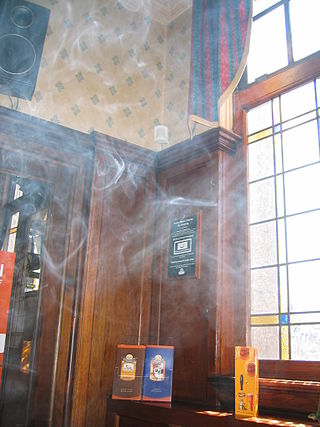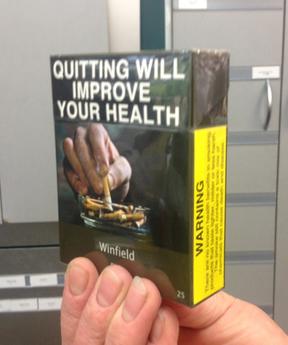Related Research Articles

A cigarette is a narrow cylinder containing a combustible material, typically tobacco, that is rolled into thin paper for smoking. The cigarette is ignited at one end, causing it to smolder; the resulting smoke is orally inhaled via the opposite end. Cigarette smoking is the most common method of tobacco consumption. The term cigarette, as commonly used, refers to a tobacco cigarette, but the word is sometimes used to refer to other substances, such as a cannabis cigarette or an herbal cigarette. A cigarette is distinguished from a cigar by its usually smaller size, use of processed leaf, and paper wrapping, which is typically white.

The tobacco industry comprises those persons and companies who are engaged in the growth, preparation for sale, shipment, advertisement, and distribution of tobacco and tobacco-related products. It is a global industry; tobacco can grow in any warm, moist environment, which means it can be farmed on all continents except Antarctica.

Tobacco smoking is the practice of burning tobacco and ingesting the resulting smoke. The smoke may be inhaled, as is done with cigarettes, or simply released from the mouth, as is generally done with pipes and cigars. The practice is believed to have begun as early as 5000–3000 BC in Mesoamerica and South America. Tobacco was introduced to Eurasia in the late 17th century by European colonists, where it followed common trade routes. The practice encountered criticism from its first import into the Western world onwards but embedded itself in certain strata of a number of societies before becoming widespread upon the introduction of automated cigarette-rolling apparatus.

Smoking bans, or smoke-free laws, are public policies, including criminal laws and occupational safety and health regulations, that prohibit tobacco smoking in certain spaces. The spaces most commonly affected by smoking bans are indoor workplaces and buildings open to the public such as restaurants, bars, office buildings, schools, retail stores, hospitals, libraries, transport facilities, and government buildings, in addition to public transport vehicles such as aircraft, buses, watercraft, and trains. However, laws may also prohibit smoking in outdoor areas such as parks, beaches, pedestrian plazas, college and hospital campuses, and within a certain distance from the entrance to a building, and in some cases, private vehicles and multi-unit residences.

Passive smoking is the inhalation of tobacco smoke, commonly called secondhand smoke (SHS) or environmental tobacco smoke (ETS), by individuals other than the active smoker. It occurs when tobacco smoke diffuses into the surrounding atmosphere as an aerosol pollutant, which leads to its inhalation by nearby bystanders within the same environment. Exposure to secondhand tobacco smoke causes many of the same diseases caused by active tobacco smoking, although to a lower prevalence due to the reduced concentration of smoke that enters the airway. The health risks of secondhand smoke are a matter of scientific consensus, and have been a major motivation for anti-smoking laws in workplaces and indoor venues, including smoke-free restaurants, bars and night clubs, as well as some open public spaces.

Nicotine marketing is the marketing of nicotine-containing products or use. Traditionally, the tobacco industry markets cigarette smoking, but it is increasingly marketing other products, such as electronic cigarettes and heated tobacco products. Products are marketed through social media, stealth marketing, mass media, and sponsorship. Expenditures on nicotine marketing are in the tens of billions a year; in the US alone, spending was over US$1 million per hour in 2016; in 2003, per-capita marketing spending was $290 per adult smoker, or $45 per inhabitant. Nicotine marketing is increasingly regulated; some forms of nicotine advertising are banned in many countries. The World Health Organization recommends a complete tobacco advertising ban.

Philip Morris International Inc. (PMI) is an American multinational tobacco company, with products sold in over 180 countries. The most recognized and best selling product of the company is Marlboro. Philip Morris International is often referred to as one of the companies comprising Big Tobacco.
The Advancement of Sound Science Center (TASSC), formerly The Advancement of Sound Science Coalition, was an industry-funded lobby group and crisis management vehicle, and was created in 1993 by Phillip Morris and APCO in response to a 1992 United States Environmental Protection Agency (EPA) report which identified secondhand smoke as a "confirmed" human carcinogen. TASSC's stated objectives were to: (1) discredit the EPA report; (2) fight anti-smoking legislation; and (3) pro-actively pass legislation favourable to the tobacco industry.
Operation Berkshire is the name of a program initiated in 1976 by seven of the world's major tobacco companies aimed at promoting "controversy" over smoking and disease.

In the early 20th century, German researchers found additional evidence linking smoking to health harms, which strengthened the anti-tobacco movement in the Weimar Republic and led to a state-supported anti-smoking campaign. Early anti-tobacco movements grew in many nations from the middle of the 20th century. The 1933–1945 anti-tobacco campaigns in Nazi Germany have been widely publicized, although stronger laws than those passed in Germany were passed in some American states, the UK, and elsewhere between 1890 and 1930. After 1941, anti-tobacco campaigns were restricted by the Nazi government.

A Frank Statement to Cigarette Smokers was a historic first advertisement in a campaign run by major American tobacco companies on January 4, 1954, to create doubt by disputing recent scientific studies linking smoking cigarettes to lung cancer and other dangerous health effects.

Tobacco politics refers to the politics surrounding the use and distribution of tobacco.

Tobacco control is a field of international public health science, policy and practice dedicated to addressing tobacco use and thereby reducing the morbidity and mortality it causes. Since most cigarettes and cigars and hookahs contain/use tobacco, tobacco control also concerns these. E-cigarettes do not contain tobacco itself, but (often) do contain nicotine. Tobacco control is a priority area for the World Health Organization (WHO), through the Framework Convention on Tobacco Control. References to a tobacco control movement may have either positive or negative connotations, depending upon the commentator.

Tobacco has a long history in the United States.

Smokingamong youth and adolescents is an issue that affects countries worldwide. While the extent to which smoking is viewed as a negative health behavior may vary across different nations, it remains an issue regardless of how it is perceived by different societies. The United States has taken numerous measures, ranging from changes in national policy surrounding youth cigarette access to changes in media campaigns, in attempts to eliminate the use of tobacco products among teenagers. Approximately 90% of smokers begin smoking prior to the age of 18.
The majority of lifelong smokers begin smoking habits before the age of 24, which makes the college years a critical time for tobacco companies to convince college students to pick up the habit of cigarette smoking. Cigarette smoking in college is seen as a social activity by those who partake in it, and more than half of the students that are users do not consider themselves smokers. This may be because most college students plan to quit smoking by the time that they graduate.

Plain tobacco packaging, also known as generic, neutral, standardised or homogeneous packaging, is packaging of tobacco products, typically cigarettes, without any branding, including only the brand name in a mandated size, font and place on the pack, in addition to the health warnings and any other legally mandated information such as toxic constituents and tax-paid stamps. The appearance of all tobacco packs is standardised, including the colour of the pack.
The Public Finance Balance of Smoking in the Czech Republic was a 2001 report commissioned by Philip Morris's Czech division following concerns raised by the Czech health ministry that smoking's costs outweighed its fiscal benefits. The study was conducted by Arthur D. Little and found that smokers' early mortality and cigarette-tax revenue outweighed the costs of health-care and lost tax revenue from early death. The study concluded through cost-benefit analysis "based on up-to-date reliable data and consideration of all relevant contributing factors, the effect of smoking on the public finance balance in the Czech Republic in 1999 was positive, estimated at +5,815 mil. CZK."
The Center for Indoor Air Research was a tobacco industry front group established by three American tobacco companies—Philip Morris, R.J. Reynolds, and Lorillard—in Linthicum, Maryland, in 1988. The organization funded research on indoor air pollution, some of which pertained to passive smoking and some of which did not. It also funded research pertaining to causes of lung cancer other than passive smoking, such as diet. The organization disbanded in 1998 as a result of the Tobacco Master Settlement Agreement.
A heated tobacco product (HTP) is a tobacco product that heats the tobacco at a lower temperature than conventional cigarettes. These products contain nicotine, which is a highly addictive chemical. The heat generates an aerosol or smoke to be inhaled from the tobacco, which contains nicotine and other chemicals. HTPs may also contain additives not found in tobacco, including flavoring chemicals. HTPs generally heat tobacco to temperatures under 600 °C (1100 °F), a lower temperature than conventional cigarettes.
References
- ↑ Soule, Sarah A. "Social Movements and Markets, Industries, and Firms". Organization Studies. 33 (12): 1715–1733. doi:10.1177/0170840612464610.
- ↑ Givel, Michael (Jun 2007). "Consent and counter-mobilization: the case of the national smokers alliance". Journal of Health Communication. London: Taylor & Francis. 12 (4): 339–57. doi:10.1080/10810730701326002. ISSN 1081-0730. PMID 17558787. S2CID 20124171.
- ↑ Beder, Sharon (Summer 1998). "Public Relations' Role in Manufacturing Artificial Grass Roots Coalitions". Public Relations Quarterly. 43 (2): 21–3. Archived from the original on 26 October 2018. Retrieved 23 April 2011.
- ↑ Freeman, Becky; Chapman, Simon (June 2007). "Is "YouTube" telling or selling you something? Tobacco content on the YouTube video-sharing website". Tobacco Control. London: BMJ Group. 16 (3): 207–210. doi:10.1136/tc.2007.020024. PMC 2598506 . PMID 17565142.
- ↑ Gerry McCusker (2005). Talespin: public relations disasters—inside stories & lessons learnt . Kogan Page Publishers. pp. 13–14. ISBN 978-0-7494-4259-0 . Retrieved 23 April 2011.
- ↑ "Talk-Show Pioneer Morton Downey Jr. Dies". ABC News. 13 March 2001. Retrieved 23 April 2011.
- ↑ Philip Morris U.S.A. Withdraws Support for National Smokers Alliance; Condemns Personal Attack On Senator McCain [ dead link ], Business Wire, June 29, 1999